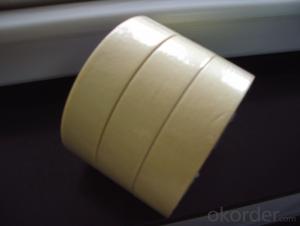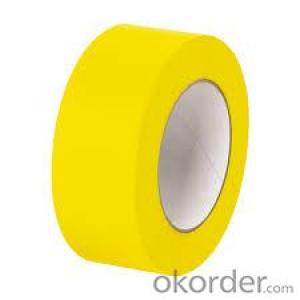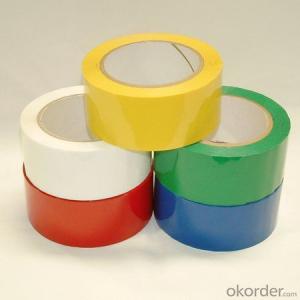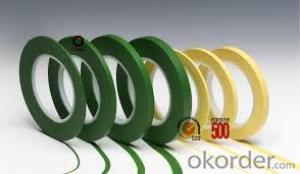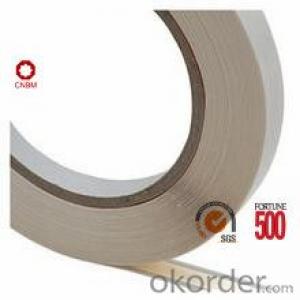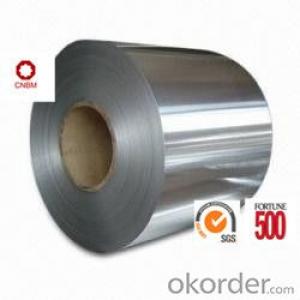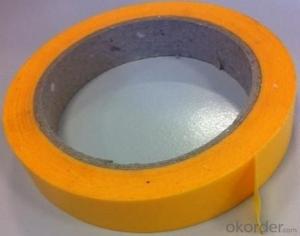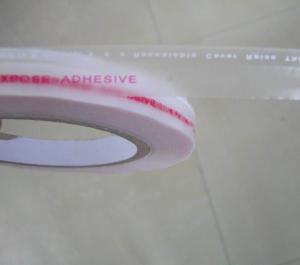Eco Friendly Clear Packaging Tape - No Residue Masking Tape in Various Colors MY-68
- Loading Port:
- China Main Port
- Payment Terms:
- TT OR LC
- Min Order Qty:
- -
- Supply Capability:
- -
OKorder Service Pledge
OKorder Financial Service
You Might Also Like
product description:
Quick details:
Material: Crepe Paper
Use: Decoration , Car Painting
Adhesive Side: Single Sided
Adhesive: Rubber
Place of Origin: China (Mainland)
color: natural, white, yellow, black, green, red, black, blue, etc.
Specifications:
Item No. Carrier Adhesive Total
ThicknessInitial
TackHolding
PowerTensile
StrengthElongation Temperature
resistanceUV
resistanceMY580 crepe paper rubber 160 micron 10# 2h 16N/cm <12% 60DC -- MY690 crepe paper rubber 150 micron 8# 3h 16N/cm <12% 60DC -- MY6929 crepe paper rubber 150 micron 10# 3h 16N/cm <10% 80DC -- M110 crepe paper rubber 160 micron 8# 3h 26N/cm <10% 110DC -- M130 crepe paper rubber 160 micron 13# 4h 26N/cm <10% 130DC -- M07 crepe paper rubber 130 micron 9# 3h 26N/cm < 20% 60DC -- M08 crepe paper rubber 130 micron 10# 5h 26N/cm <16% 70DC -- M09 crepe paper rubber 145 micron 12# 10h 24N/cm <20% 80DC -- M20F crepe paper water based
acrylic140 micron 10# 10h 26N/cm <20% 90DC 7 days Application:
MY580, MY690, MY6929, M07, M08 are mainly used for room temperature application such as interior painting masking, silk screening, light duty packaging, bunding, holding, splicing & tabbing, and other non-critical applications where a pressure-sensitive tape is needed. MY110, MY130, M09 are mainly used for high temperature application such as car painting etc. M20F is for UV resistant application....
Packing:Paper Core ID: 76mm
Jumbo size: 0.99m x 1800m, 1.22m x 1800m, 1.51m x 1800m
Cut roll size: As per customer's requirementCut rolls: Shrink package, placed in cartons, with or without pallet
Jumbo rolls & log rolls: Packed with kraft paper and stretch wrap film, with or without pallet
Cut rolls: Shrink package, placed in cartons, with or without pallet
Jumbo rolls & log rolls: Packed with kraft paper and stretch wrap film, with or without palletCompany Advantages:
1. Stable financial status and sound reputation as a state invested corporation under the direct administration of the State Council of PRC;
2. CNBM’s world wide influence as one of the 500 global fortunes specializing in building materials including adhesive tapes;
3. More than a decade’s exporting experience and technology in adhesive tape industry;
4. Preferencial shipping channels, with a separate team dealing with shipping.
- Q: Does packaging tape have a specific weight capacity?
- Packaging tape indeed possesses a specific weight capacity. The weight capacity of packaging tape relies on its thickness, width, and overall quality. Typically, packaging tapes are engineered to effectively seal boxes and packages, with their weight capacity determined by their adhesive strength and resilience. The majority of standard packaging tapes can handle a weight capacity ranging from approximately 20 to 30 pounds. Nonetheless, there are heavy-duty packaging tapes available that can manage weights of 50 pounds or more. It is crucial to take into account the weight of the package or box that requires sealing and opt for a packaging tape that can accommodate the precise weight capacity in order to ensure a secure and dependable seal.
- Q: Can packaging tape be used for sealing cloth or fabric items?
- Packaging tape has the capability of sealing cloth or fabric items. Its design ensures strength and adhesive properties, making it efficient for securing and sealing different materials, such as cloth and fabric. When it comes to packages containing cloth or fabric items, packaging tape becomes particularly handy as it ensures a secure closure that prevents any potential damage or loss during transportation or storage. Furthermore, the transparency of packaging tape allows for effortless identification of the contents while maintaining the overall appearance of the cloth or fabric item intact.
- Q: Are there any eco-friendly options for packaging tape?
- Yes, there are eco-friendly options for packaging tape available in the market today. Traditional packaging tapes are typically made from plastic materials such as polypropylene or PVC, which are not biodegradable and have a negative impact on the environment. However, eco-friendly alternatives have been developed to address this issue. Some options include: 1. Paper-based packaging tape: These tapes are made from renewable resources such as paper and natural adhesives. They are biodegradable, compostable, and recyclable, making them a sustainable choice for packaging needs. 2. Water-activated tape: Also known as gummed paper tape, this type of tape is made from paper and requires water to activate the adhesive. It forms a strong bond when applied to boxes and is tamper-evident. Water-activated tape is biodegradable and can be recycled along with the packaging it is applied to. 3. Biodegradable and compostable tape: These tapes are made from plant-based materials such as cellulose or PLA (polylactic acid). They are designed to break down naturally over time, reducing their impact on the environment. Some options are certified as compostable, meaning they can be added to compost piles or sent to composting facilities. 4. Recycled plastic tape: While traditional plastic tapes are not eco-friendly, there are recycled plastic tape options available in the market. These tapes are made from recycled plastic materials, reducing the demand for virgin plastic and promoting a circular economy. When looking for eco-friendly packaging tape, it is important to consider certifications such as the Forest Stewardship Council (FSC) for paper-based tapes or the Biodegradable Products Institute (BPI) certification for compostable tapes. By choosing these alternatives, individuals and businesses can minimize their environmental footprint and contribute to a more sustainable future.
- Q: Can packaging tape be used for sealing packages with delicate fabrics or clothing?
- Sealing packages containing delicate fabrics or clothing with packaging tape is possible. However, it is crucial to exercise caution and implement specific precautions to ensure the protection of these fragile items. Here are some tips to guarantee safe packaging: 1. Opt for a broad, transparent packaging tape: Select a tape that provides a larger adhesion surface area due to its width. Transparent tape is preferable as it reduces the risk of leaving visible residue or marks on the fabric. 2. Apply a double layer of tape: Enhance the strength and security of the package by using two layers of packaging tape. This will help prevent accidental peeling during transit. 3. Securely wrap the delicate items: Before sealing the package, make sure to wrap the delicate fabrics or clothing in a protective layer such as tissue paper or bubble wrap. This additional layer will act as a buffer, safeguarding the items from potential damage caused by the tape. 4. Avoid excessive tension: Exercise caution while sealing the package and avoid pulling the tape too tightly. Excessive tension may stretch or distort the fabric, potentially damaging the delicate item. 5. Explore alternative options: For particularly fragile or valuable delicate items, it may be beneficial to consider alternative packaging materials such as acid-free tissue paper or garment bags. These options offer additional protection and are specifically designed for preserving delicate fabrics and clothing. Ultimately, while packaging tape can be utilized for sealing packages containing delicate fabrics or clothing, it is essential to handle the items with care and implement appropriate measures to minimize the potential for damage during the packaging process.
- Q: Is packaging tape flammable?
- Packaging tape is generally not flammable. Most packaging tapes are made from materials like polypropylene or polyester which have high melting points and are resistant to flames. However, it is important to note that the adhesive used on the tape may vary depending on the brand and type of tape. Some adhesive formulations may contain flammable components, but these are typically present in very small amounts and are unlikely to cause a significant fire hazard. Nonetheless, it is always recommended to follow the manufacturer's instructions and keep packaging tapes away from open flames or potential sources of ignition to ensure safety.
- Q: Is packaging tape flammable?
- Yes, packaging tape is typically made from materials such as polypropylene or polyester, which are not highly flammable. However, it is important to note that some packaging tapes may have adhesive properties that contain flammable components. It is always best to refer to the specific packaging tape's safety data sheet or consult the manufacturer for accurate information regarding flammability.
- Q: Can packaging tape be used for sealing packages with high-value contents?
- Yes, packaging tape can be used for sealing packages with high-value contents. However, it is important to ensure that the tape used is strong, durable, and tamper-evident to provide adequate security and protection for the valuable contents.
- Q: Can packaging tape be printed with custom logos or designs?
- Indeed, it is possible to imprint packaging tape with personalized logos or designs. Numerous firms provide the opportunity to personalize packaging tape with your very own logo, text, or design. This enables enterprises to establish a distinctive and polished appearance for their parcels, thereby improving their brand's image and setting their packages apart. The utilization of bespoke printed packaging tape serves as an excellent means to advertise your company and establish a unified and branded packaging encounter for your clientele.
- Q: Can packaging tape be used for sealing moving boxes?
- Indeed, when it comes to sealing moving boxes, packaging tape proves to be quite useful. Its design is specifically tailored to secure boxes and packages during transit, boasting durability and strength that ensure a tight seal, preventing boxes from opening or items from spilling out. Moreover, its application is quick and effective, making it an easy-to-use option. It is worth noting that packaging tape often possesses resistance against moisture and can withstand diverse weather conditions, which makes it an ideal choice for long-distance moves or storage purposes. In summary, packaging tape is a dependable solution for sealing moving boxes and guaranteeing the safety of your belongings throughout the moving process.
- Q: Is packaging tape resistant to chemicals or solvents?
- Generally, chemicals and solvents do not pose a threat to packaging tape. Packaging tapes are typically composed of materials like polypropylene or polyvinyl chloride (PVC), which possess excellent chemical resistance. These materials are specifically engineered to endure exposure to a broad array of chemicals and solvents commonly found in industrial or commercial settings. Nevertheless, it is crucial to acknowledge that the resistance of packaging tape may differ depending on factors such as the brand, type, and quality of the tape. Consequently, it is advisable to review the product specifications or seek guidance from the manufacturer to obtain detailed information regarding the chemical resistance of a particular tape.
Send your message to us
Eco Friendly Clear Packaging Tape - No Residue Masking Tape in Various Colors MY-68
- Loading Port:
- China Main Port
- Payment Terms:
- TT OR LC
- Min Order Qty:
- -
- Supply Capability:
- -
OKorder Service Pledge
OKorder Financial Service
Similar products
Hot products
Hot Searches
